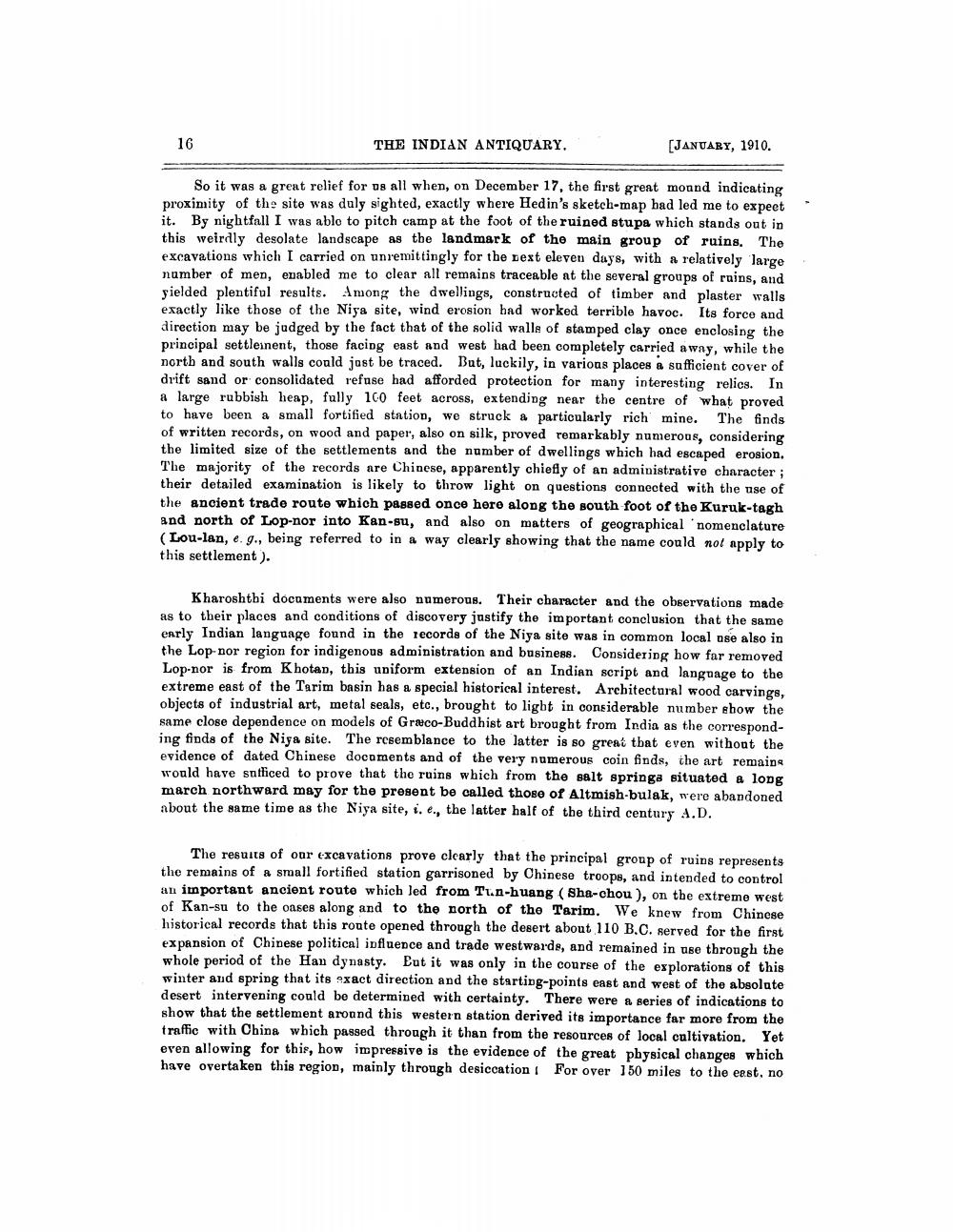________________
16
THE INDIAN ANTIQUARY.
[JANUARY, 1910.
So it was a great relief for us all when, on December 17, the first grent mound indicating proximity of the site was duly sighted, exactly where Hedin's sketch-map had led me to expeet it. By nightfall I was ablo to pitch camp at the foot of the ruined stupa which stands out in this weirdly desolate landscape as the landmark of the main group of ruins. The excavations which I carried on unremittingly for the next eleven days, with a relatively large number of men, enabled me to clear all remains traceable at the several groups of ruins, and yielded plentiful results. Among the dwellings, constructed of timber and plaster walls exactly like those of the Niya site, wind erosion had worked terrible havoc. Its force and direction may be judged by the fact that of the solid walls of stamped clay once enclosing the principal settleinent, those facing east and west had been completely carried away, while the north and south walls could jast be traced. But, luckily, in various places a safficient cover of drift sand or consolidated refuse had afforded protection for many interesting relics. In a large rubbish heap, fully 100 feet across, extending near the centre of what proved to have been a small fortified station, we struck & particularly rich mine. The finds of written records, on wood and paper, also on silk, proved remarkably numerous, considering the limited size of the settlements and the number of dwellings which had escaped erosion. The majority of the records are Chinese, apparently chiefly of an administrative character ; their detailed examination is likely to throw light on questions connected with the use of the ancient trade route which passed once here along the south foot of the Kuruk-tagh and north of Lop-nor into Kan-su, and also on matters of geographical nomenclature (Lou-lan, e.g., being referred to in a way clearly showing that the name could not apply to this settlement).
Kharoshthi documents were also numerous. Their character and the observations made as to their places and conditions of discovery justify the important conclusion that the same early Indian language found in the records of the Niya site was in common local use also in the Lop-nor region for indigenous administration and business. Considering how far removed Lop-nor is from Khotan, this uniform extension of an Indian script and language to the extreme east of the Tarim basin has a special historical interest. Architectural wood carvings, objects of industrial art, metal seals, etc., brought to light in considerable number show the same close dependence on models of Græco-Buddhist art brought from India as the corresponding finds of the Niga site. The resemblance to the latter is so great that even without the evidence of dated Chinese documents and of the very numerous coin finds, the art remains would have snfficed to prove that the ruins which from the salt springa situated a long march northward may for the present be called those of Altmish bulak, were abandoned about the same time as the Niya site, i. e., the latter half of the third century A.D.
The results of our excavations prove clearly that the principal group of ruins represents the remains of a small fortified station garrisoned by Chinese troops, and intended to control an important ancient route which led from Tun-huang (Sha-chou ), on the extreme west of Kan-su to the onses along and to the north of the Tarim. We knew from Chinese historical records that this route opened through the desert about 110 B.C. served for the first expansion of Chinese political influence and trade westwards, and remained in use through the whole period of the Han dynasty. But it was only in the course of the explorations of this winter and spring that its exact direction and the starting-points east and west of the absolute desert intervening could be determined with certainty. There were a series of indications to show that the settlement around this western station derived its importance far more from the traffic with China which passed through it than from the resources of local cultivation. Yet eren allowing for this, how impressive is the evidence of the great physical changes which have overtaken this region, mainly through desiccation For over 150 miles to the east, no




